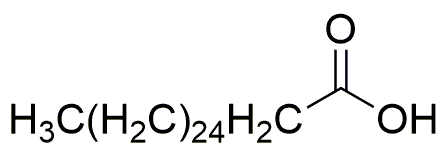Heptacosanoic acid is widely utilized in research focused on:
- Biotechnology: This fatty acid serves as a substrate for microbial fermentation processes, enhancing the production of biofuels and other bioproducts.
- Cosmetics: It is incorporated into skincare formulations for its emollient properties, providing moisture and improving skin texture.
- Food Industry: Used as a food additive, it can enhance flavor profiles and improve the stability of certain food products.
- Pharmaceuticals: Heptacosanoic acid is explored for its potential therapeutic effects, including anti-inflammatory properties, making it a candidate for drug development.
- Materials Science: It is utilized in the synthesis of surfactants and lubricants, contributing to improved performance in industrial applications.
General Information
Properties
Safety and Regulations
Applications
Heptacosanoic acid is widely utilized in research focused on:
- Biotechnology: This fatty acid serves as a substrate for microbial fermentation processes, enhancing the production of biofuels and other bioproducts.
- Cosmetics: It is incorporated into skincare formulations for its emollient properties, providing moisture and improving skin texture.
- Food Industry: Used as a food additive, it can enhance flavor profiles and improve the stability of certain food products.
- Pharmaceuticals: Heptacosanoic acid is explored for its potential therapeutic effects, including anti-inflammatory properties, making it a candidate for drug development.
- Materials Science: It is utilized in the synthesis of surfactants and lubricants, contributing to improved performance in industrial applications.
Documents
Safety Data Sheets (SDS)
The SDS provides comprehensive safety information on handling, storage, and disposal of the product.
Product Specification (PS)
The PS provides a comprehensive breakdown of the product’s properties, including chemical composition, physical state, purity, and storage requirements. It also details acceptable quality ranges and the product's intended applications.
Certificates of Analysis (COA)
Search for Certificates of Analysis (COA) by entering the products Lot Number. Lot and Batch Numbers can be found on a product’s label following the words ‘Lot’ or ‘Batch’.
*Catalog Number
*Lot Number
Certificates Of Origin (COO)
This COO confirms the country where the product was manufactured, and also details the materials and components used in it and whether it is derived from natural, synthetic, or other specific sources. This certificate may be required for customs, trade, and regulatory compliance.
*Catalog Number
*Lot Number
Safety Data Sheets (SDS)
The SDS provides comprehensive safety information on handling, storage, and disposal of the product.
DownloadProduct Specification (PS)
The PS provides a comprehensive breakdown of the product’s properties, including chemical composition, physical state, purity, and storage requirements. It also details acceptable quality ranges and the product's intended applications.
DownloadCertificates of Analysis (COA)
Search for Certificates of Analysis (COA) by entering the products Lot Number. Lot and Batch Numbers can be found on a product’s label following the words ‘Lot’ or ‘Batch’.
*Catalog Number
*Lot Number
Certificates Of Origin (COO)
This COO confirms the country where the product was manufactured, and also details the materials and components used in it and whether it is derived from natural, synthetic, or other specific sources. This certificate may be required for customs, trade, and regulatory compliance.

